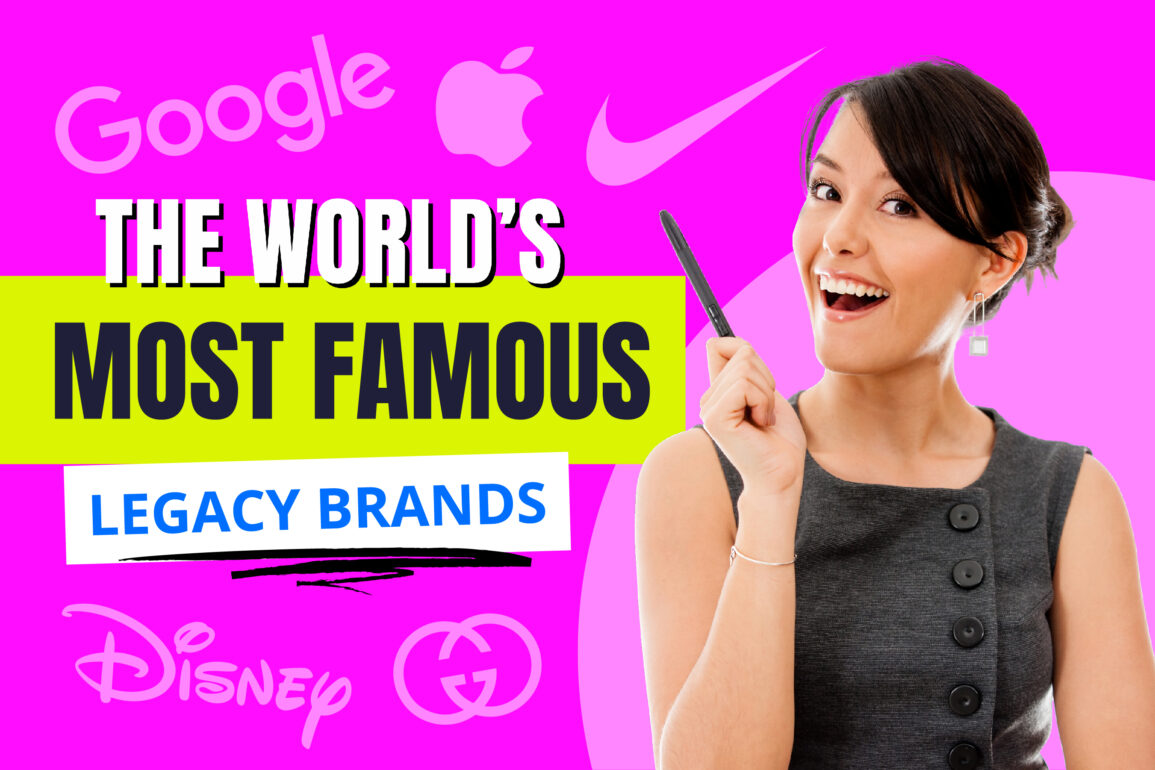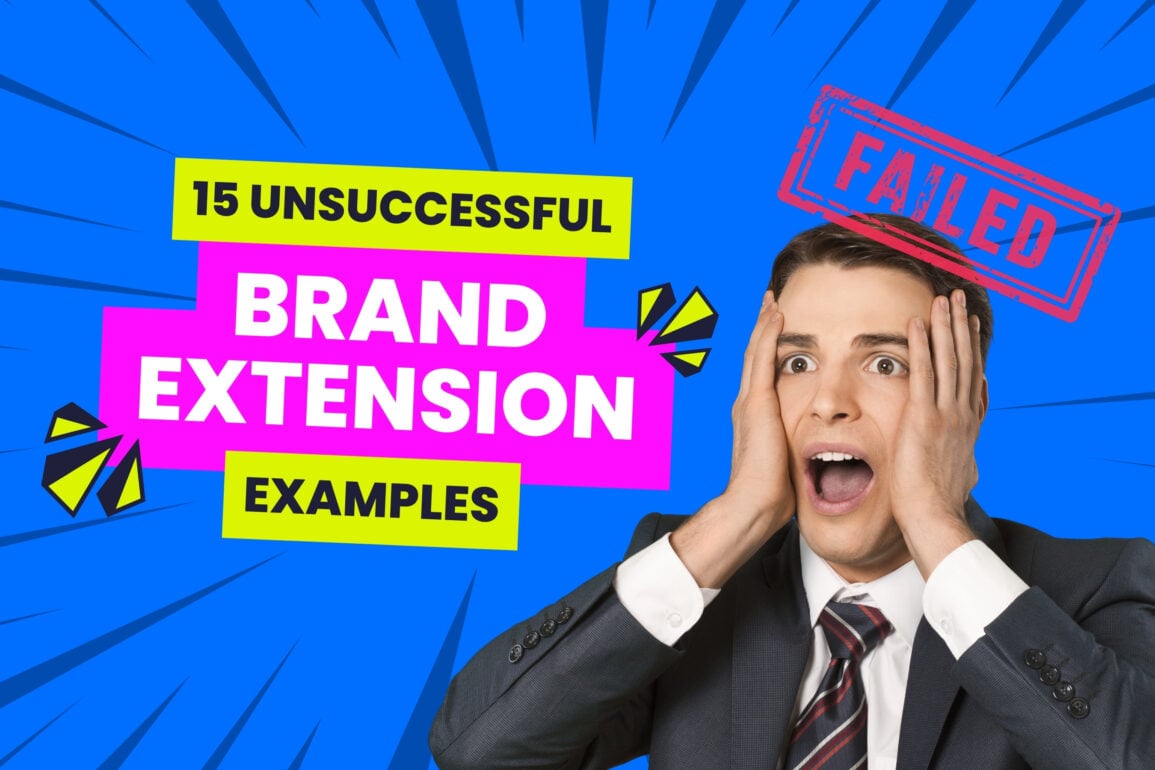An introduction to the world’s most famous legacy brands

We all know at least a few legacy brands. Who isn’t familiar with Coca-Cola, Disney, Rolex, Nike, and Levi’s for instance? All of these companies are global giants, standing on the highest pillars in their industries, and capturing a massive share of their target market.
But what is a legacy brand, exactly? When most people hear the word “legacy” they think of heritage, history, and maybe even a touch of nostalgia. However, there’s more to “legacy branding” than just having a company that’s been around for a few years (or decades).
Legacy brands aren’t just “old companies”. While they usually do have a longer history than newer brands, they also have an amazing reputation.
Legacy companies are the organizations with a massive amount of brand equity. They’ve successfully carved a space for themselves in their niche that ensures they stand the test of time.
Intrigued?
Today we’re going to tell you everything you need to know about building a legacy brand, with some handy examples from the most famous legacy companies of all time.

What is a legacy brand? Legacy brand meaning
Let’s start with a quick “legacy brand definition”. A legacy brand is a company with an extensive history, and a strong reputation. They have well-known products, and might even be considered the “go-to” provider in their niche.
For instance, when you hear “search engine”, you think “Google”.
So, why is legacy branding so valuable?
There are a few reasons. First, if you successfully create a legacy brand, then that probably means your business is thriving. After all, about 1 in 5 businesses fail within their first year. If your company survives decades, then you’re clearly doing something right.
Additionally, let’s face it – most of us trust legacy brands more than their competitors. Legacy brands have built a reputation for excellence over the years. They constantly demonstrate a commitment to their customers, and have a strong emotional connection with their target audience.
They’re also (usually) more profitable. Since we see legacy brands, and their products as more valuable, we’re willing to pay more for whatever these companies offer.
We associate legacy with quality, particularly when these companies use the right messaging and marketing strategies.
Think of it this way, if you’re splashing out on a great watch, would you be more likely to spend big bucks on a Rolex, or on a new “luxury” watch from a brand you’ve never heard of?

Creating brand legacy: How to build a legacy brand
So, how do you go about “creating brand legacy”? Well, the bad news is it doesn’t happen overnight. You can’t just launch a business and expect it to become an instant legacy.
Even if you can trace the history of your products and company back through the centuries, it takes time to convince customers you have a genuine “legacy”. Legacy branding takes time. You need to focus on constantly strengthening your connection with your customers over the decades.
Still, there are a few things you’ll need to invest in if you want to improve your chances of becoming a legacy in the eyes of your customers:
Step 1: Have a clear purpose, mission, and story
All great brands need a purpose (beyond just making money). You need a mission and vision that ensures you can connect with your customers. For instance, Coca-Cola wants to inspire joy and make a difference – not just create fizzy drinks.
What makes legacy brands different is the story behind their mission, vision, and purpose. Every legacy brand you can think of has an amazing story, one that’s steeped with emotion.
Legacy brands weave historical narratives about the challenges they’ve overcome, the inspiration that drives them, and the goals they stive to achieve. For instance, Levi’s was founded when Levi Strauss recognized the need for durable clothing for the working class.
They wanted to create products that served a specific need, but also enriched and improved the lives of their customers. The company continues to build on this story, with campaigns and initiatives that show its commitment to its customers, and a strong approach to corporate social responsibility.
Step 2: Build a consistent brand identity
This is another factor that applies to just about any successful brand. You need a strong brand identity if you’re going to capture the hearts and minds of your target audience.
Your brand identity isn’t just made up of your logo, color palette, and business name, it also includes everything from your tone of voice to your company’s personality. What really helps legacy brands shine, is their commitment to building a “consistent” identity.
Nike, for instance, has used the “swoosh” mark in its logo, aligned with the concept of achievement, for decades. The company’s messaging doesn’t just promote shoes and active wear, it aims to connect with, and inspire audiences from every walk of life.
Step 3: Invest in a strong customer focus
Do you think any business would really last for decades, if it didn’t put its customers first? Companies are elevated to legacy status because they earn the advocacy and loyalty of their target audience.
If Starbucks just churned out sub-standard coffee without investing in connecting with its customers, would people constantly post photos of their lattes online? If they only showed an interest in making money, would customers really support them? Nope.
Part of what helps a legacy or heritage brand thrive through the years is its ability to deliver memorable experiences, and reach customers on an emotional level.
Legacy companies invest in extensive market research, and get to know their audience on a deeper level, so they can transform every customer into an advocate. They build on the voices of their loyal customers, inspiring endless word-of-mouth marketing.
Step 4: Find your point of differentiation
Every brand needs to have a point of differentiation – something that separates it from the competition. Legacy brands are often more invested in this than most. After all, the more time you spend in your market, the more competitors you’ll attract.
Going back to Coca-Cola as an example again, there are hundreds of companies out there who sell similar beverages and products. Coca-Cola doesn’t sell the cheapest products to attract customers, instead, they position themselves as the “original”. The OG of carbonated drinks.
They use their legacy branding potential to draw attention to the fact that they were the people to introduce us to “cola” in the first place. Plus, they constantly remind us that their product is the “real thing”, making it seem more valuable than competing options.
Step 5: Be ready to adapt
Just having a company that’s been around for a while doesn’t guarantee you’re going to be successful forever. Just look at some major staple brands that have closed down over the years, such as Toys R Us. You can’t just rely on nostalgia to keep customers coming back.
Legacy brands thrive because they adapt. They change to address evolving customer needs. When McDonalds first launched, it was designed to appeal to people who just wanted a quick meal.
Over the years, customer priorities changed, and people wanted healthier food, and transparency about where ingredients came from. As a result, the dynasty brand changed tactics, offering new menu items, sharing insights into its sourcing process, and adapting its marketing campaigns.
Legacy brand examples: The most famous legacy brands
Now you know what it takes to create a legacy brand strategy, let’s dive into some examples. There are plenty of great legacy brands that probably come to mind whenever you think of companies that have stood the test of time, but here are some of our favorites.

1. Porsche
What comes to mind when you hear the word “Porsche”, or see that iconic shield logo? For us, it’s luxury, elegance, and excellence. Porsche doesn’t just create cars, it designs immersive lifestyle experiences for its customers, connecting with their quest for automotive perfection.
First created in 1931, Porsche has been around for decades, constantly innovating and finding new ways to enthuse its audience. Though other luxury car companies exist, few have the heritage and history of the Porsche brand.
The Porsche crest is seen as a symbol of success by car buyers, and also offers an insight into the company’s background, with references to where it was created.
Porsche marketing campaigns are emotional and evocative, they help customers visualize what it would feel like to be a member of the Porsche community. Plus, Porsche is committed to constantly sharing its history with its audience.
Just take a look at this incredible page on the Porsche website, offering a comprehensive guide to the evolution, and origins of Porsche vehicles.

2. Nike
Nike is one of the most successful legacy clothing brands of all time. Introduced in 1964, as “Blue Ribbon Sports”, Nike isn’t the oldest activewear company out there, but it is one of the most memorable. It shares its mission and vision in everything it does.
Nike doesn’t just sell activewear and sports equipment, it wants to turn every potential customer into an athlete. This means it’s constantly focusing on inspiring and motivating its audience. Taglines like “Just do it”, fill us with a sense of ambition and purpose.
Nike’s logo, based on the wing of the Greek Goddess Nike (also the inspiration for the company’s name), looks like a checkmark, reminding us of its focus on success.
Nike’s marketing campaigns position every customer as the “hero” of the story. They’ve used everything from user-generated content to stories from celebrities in their ads. Plus, Nike’s ability to adapt and change over the years means it hasn’t lost the attention of younger consumers.

3. Disney
Everyone has heard of Disney. Literally everyone. We challenge you to go out and try to find someone who can’t name at least one Disney property, whether it’s a theme park or a movie.
So, what makes Disney so phenomenally successful? Its commitment to creating unique products, like new movies, films, and shows is one aspect. However, the connection most people feel with Disney goes much deeper than this.
Disney is all about stories. From the stories it tells in its movies, to the narrative it has built around itself. We all know about Walt Disney, and how he crafted the animated mouse that would change the world of entertainment forever.
The company also shares its history in everything it does. Even the logo of the Disney brand is based on a signature from Walt Disney himself. What’s more, Disney doesn’t just sell products, it sells experiences. It’s all about “magic” and wonder.

4. Google
Probably the most well-known brand in the digital age, Google is a little younger than some of the other legacy brands mentioned here, but that doesn’t make it any less successful. Google has effectively shaped how we feel, think, and talk about the online world.
The name “Google” is both a verb and a noun. Since Google is the world’s most popular and best-known search engine, we’ve grown to adopt the word into our conversations. How many times have you told someone to “Google it” when they’re looking for answers or information?
Interestingly, Google wasn’t the world’s first search engine (that was something called Archie). However, it was the first engine to transform our online experiences. Google made finding information online easier, and more streamlined.
It continues to do this today, constantly updating its algorithms to ensure customers get the best results for their queries. Plus, the company is a major innovator, experimenting with everything from AI, to extended reality, so it never loses relevance.

5. Starbucks
Starbucks story starts all the way back in 1971, when it opened its first store in Seattle’s Pike Place market. More than just another company selling coffee and tea, Starbucks wanted to revolutionize the hot beverage industry – and it did.
The founders of the company wanted to create coffee shops that felt like a community experience. They took the intimate experiences consumers got in cafes throughout Italy, and transformed them into a scalable, global phenomenon.
Starbucks visual identity is also extremely memorable. It might have changed a few times over the years, but the core essence remains the same. The siren makes us think of passion and desire, as well as connecting Starbucks to its nautical background.
The business, like many of the best legacy brands, also puts its customers first. It offers endless customization options to every consumer, and constantly looks for ways to inspire loyalty, through loyalty programs, and user-generated marketing campaigns.

6. Gucci
Ask any fashion lover to list some of the world’s most luxurious brands, and you’re sure to hear the name “Gucci”. While the company’s high-quality products have contributed significantly to their success, it’s the history and heritage of the business that makes it stand out.
Obsessed with the leather goods owned by the elite class when operating elevators, Guccio Gucci founded his company with a focus on luxury. He went above and beyond to source the best materials and designers in the world to create his product line.
Gucci’s commitment to artistry and attention to detail meant the company quickly became popular with the upper class. Today, celebrities regularly wear the brand’s clothing at red carpet events, and help to promote the company’s value.
Gucci also constantly demonstrates a consistent focus on prestige and quality, through all of its marketing campaigns and promotional activities. The organization has even evolved through the years, branching into the world of XR and NFTs.

7. Levi’s
Without Levi’s, the average wardrobe today would probably be very different. The company has been innovating ever since the blue jean was invented in 1873, created to give people from all classes access to more durable clothing.
Levi’s introduced the world to a new style of clothing, combining practicality, comfort, and visual appeal. The company’s visual identity is also instantly impactful. The simple red label placed on every Levi’s product is recognizable all over the world.
Like most major legacy brands, Levi’s shares its story and history with its customers, through its marketing campaigns, and its website. It’s also one of the most adaptable brands in the world. For over 100 years, Levi’s have never stopped creating new products.
For most people, Levi’s is more than just an American legacy, it’s a cultural symbol. The brand even commits to addressing the values of its current audience, with social responsibility initiatives, sustainable sourcing strategies, and “project FLX”.

8. Apple
As a relatively new company (compared to some of the brands we’ve covered here), Apple might not seem like your average legacy brand. However, this company has changed the way we think about communication and computing forever.
Apple shaped the personal computing landscape when it introduced its Mac computers back in 1984. It showed people around the world that anyone could access a computer, without needing massive servers and complicated equipment.
Then, when Apple branched into the mobile landscape, it paved the way for the smartphone revolution. The brand turned phones into phenomenal pocket computers, capable of everything from playing games, to browsing the internet.
Today, Apple still holds a significant share of the mobile industry, with its own operating system, and a slew of dedicated customers. Even the Apple visual identity, with its sleek black and white color palette, and memorable icon, conveys both history, and modernity.

9. Microsoft
Similar to Apple, Microsoft isn’t the oldest company on this list, but it is one of the most impactful. Where Apple focused on the mobile device landscape, and changing the way we communicate, Microsoft gave everyone access to the world of computing.
If you have a PC, then there’s no doubt you’ve used at least one Microsoft product, whether it’s a productivity app like Microsoft Word, or the Windows operating system.
Microsoft’s story dates back to 1975, when Bill Gates and Paul Allan built their first operating system. Over the years, Microsoft has constantly adapted to serve an ever-evolving community of digital natives.
Today, Microsoft continues to prove itself as an innovative legacy brand, by constantly experimenting with new offerings, like Microsoft Teams, designed during the pandemic, and Copilot, the new generative AI app built with OpenAI.
Legacy branding: Leaving your mark
Legacy brands are more than just companies that have been around for a while. Yes, these organizations have definitely stood the test of time. However, they’ve thrived for a few important reasons. Legacy brands innovate, build connections with customers, and adapt.
They develop their brand equity and reputation through not just comprehensive marketing campaigns, but a unique approach to storytelling, and product development.
Building a legacy brand is no easy feat – and history doesn’t guarantee you a future. However, if you can follow in the footsteps of the legacy companies mentioned above, you have the potential to create one of the most valuable businesses of all time.
Need help developing a brand with the potential to become a legacy? Reach out to the team at Fabrik Brands to discover how we can help future-proof your brand.
















